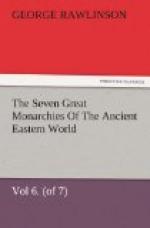It was also a general principle of Parthian warfare to abstain from campaigning during the winter. So much depended upon the tension of their bow-strings, which any dampness relaxed, that their rule was to make all their expeditions in the dry time of their year, which lasted from early in the spring until late in the autumn. The rule was, however, transgressed upon occasions. Phraates II. made his attack upon Antiochus Sidetes, while the snow was still upon the ground; and Volagases I. fell upon Paetus after the latter had sent his troops into winter quarters. The Parthians could bear cold no less than heat; though it was perhaps rather in the endurance of the latter than of the former that they surpassed the Romans. The sun’s rays were never too hot for them; and they did not need water frequently or in large quantities. The Romans believed that they increased their ability of bearing thirst by means of certain drugs which they consumed; but it may be questioned whether they really employed any other remedies than habit and resolution.
We find no use of chariots among the Parthians, except for the conveyance of the females, who accompanied the nobles upon their expeditions. The wives and concubines of the chiefs followed the camp in great numbers; and women of a less reputable class, singers, dancers, and musicians, swelled the ranks of the supernumeraries. Many of these were Greeks from Seleucia and other Macedonian towns. The commissariat and transport departments are said to have been badly organized; but some thousands of baggage camels always accompanied an army, carrying stores and provisions. Of these a considerable portion were laden with arrows, of which the supply was in this way rendered inexhaustible.
The use of the elephant in war was still more rare in Parthia than that of the chariot. While the Seleucid kings employed the animal to a large extent, and its use was also probably known to the Greek princes of Bactria, the Arsacidae appear to have almost entirely neglected it. On one occasion alone do we find their employment of it mentioned, and then we hear of only a single animal, which is ridden by the monarch. Probably the unwieldy creature was regarded by the Parthians as too heavy and clumsy for the light and rapid movements of their armies, and was thus disused during the period of their supremacy, though again employed, after Parthia had fallen, by the Sassanidse.
The Parthians entered into battle with much noise and shouting. They made no use of trumpets or horns, but employed instead the kettledrum, which resounded from all parts of the field when they made their onset. Their attack was furious. The mailed horsemen charged at speed, and often drove their spears through the bodies of two enemies at a blow. The light horse and the foot, when any was present, delivered their arrows with precision and with extraordinary force. But if the assailants were met with a stout resistance, the first vigor of




